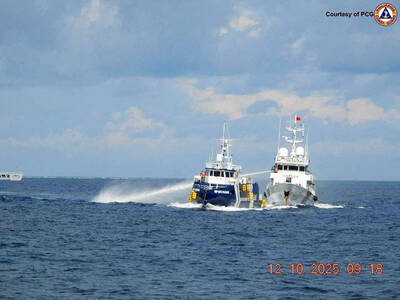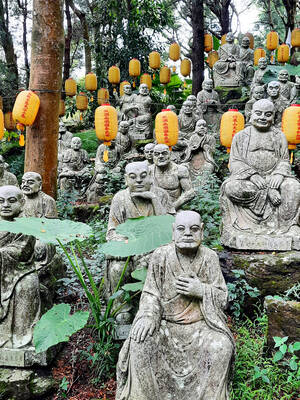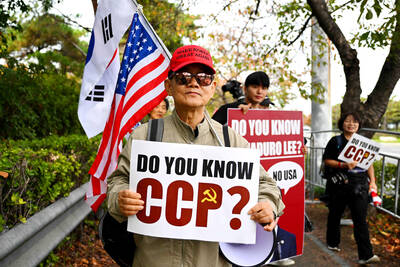It’s famous as the location of the Ho-Hai-Yan Rock Festival (海洋音樂祭) every July, but Fulong Beach (福隆海灘) offers plenty of diversions for beachgoers long after the band shell has been dismantled. The sparkle of the beach’s golden sands against a backdrop of emerald-colored hills make it postcard perfect, while the clear and temperate ocean water is popular with frolicking children and surfers alike.
Fulong Beach is bordered by both the ocean and Shuangsi River (雙溪河). As you walk over the sweeping arch of Rainbow Bridge (彩虹橋) towards the beach, take a moment to stop and savor the scenery. To your right, you will see rolling green hills, Fulong Beach Park’s (富隆海濱公園) weather-darkened wood pavilion and the gleaming exterior of Dong Sing Temple (東興官), which sits beyond the eastern edge of the beach. To the left families glide in paddleboats across the glittering surface of Shuangsi, which on a sunny day draws your eye toward a horizon with blue skies, glowing clouds — and the gleaming silver stack of a nuclear power plant.
The Fourth Nuclear Power Plant (核四) is not scheduled to go online until next year, but it has been a source of controversy since building began in 1997. Local business owners and beach-lovers complain that the construction has slowly but steadily eroded Fulong Beach into a ghost of its former self; power plant supporters blame typhoons.
Wu Xue Hua (吳雪華), the owner of Hai Du Hotel (海都旅館) at 25 Fulong St, Gongliao Township, Taipei County (台北縣貢寮鄉福隆街25號) tel: (02) 2499-1839, near the beachfront, remembers a time three or four years ago when the beach had been reduced to a slither and the ocean lapped at the foot of Rainbow Bridge. The shore has gradually reappeared, however, and Fulong is as popular as it ever was, says Wu, whose grandfather opened Hai Du Hotel 44 years ago (rooms are NT$1,200 for two people, and NT$2,000 for four people).
Wu extols the gentle virtues of the beach, which make it a relaxing place to hang out on a summer day: “The sand here is very golden, very beautiful and fine, and the beach slopes very gradually into the ocean, so it is safe to play in the water.”
Before you get to bury your toes in the shimmering sand, you must stop by the ticket booth in front of Rainbow Bridge and pay a NT$90 entrance fee (NT$70 for students). The span of beach on the opposite end of the bridge is managed by Fulong Bellevue Hotel (福隆貝悅酒店) and watched over by a pair of lifeguards. Swimmers can frolic in a roped-off swimming area from 8am to 5:30pm, at which point they are ordered out of the water (though you can dwell on the sand until 7pm).
If you feel comfortable venturing away from the lifeguards, you can extend your ocean time by heading east towards the beach in front of Dong Sing Temple by swimming along the shore or wading across the inlet that connects Shuangsi River to the ocean. While the inlet is relatively shallow, make sure to watch for undertows and the sharp rocks and occasional glass bottle that may lie beneath the water’s tepid surface.
Fulong’s clear seawater and consistent beach breaks make it a popular destination for surfers. Being Outdoors (地球人), located in front of the train station at 16 Fulong St, Gongliao Township, Taipei County (台北縣貢寮鄉福隆街16號) tel: (02) 2499-1372, offers all-day surfboard rentals from 9am to 6pm for NT$550 each. The surf shop also provides lessons and operates its own hotel, with rates starting from NT$1,200 per night for a dorm-style room that can accommodate up to four people.
Taxi-yellow paddleboats are available for adults and children aged 7 and up from stalls that are also owned and operated by Fulong Bellevue Hotel. Rental is NT$300 for boats on the ocean, while boats on Shuangsi River are NT$200.
Lazier beachgoers can spend a pleasant afternoon sifting sand between their toes and watching swimmers frolic in the waves. Renting a tatami mat will set you back NT$50; white plastic lounge chairs (NT$150) and beach umbrellas (NT$250) are also available.
We were ravenous after a day of soaking up the rays, so after rinsing off at the free showers (lockers are available for NT$30) behind the drink stand near the ticket booth, we went hunting for food. Fulong is famed for its lunchboxes, which are sold along Fulong Street near the train station and usually consist of rice topped with shrimp, fish and other seafood. At about NT$55 each, they make a cheap and quick meal for beachgoers; tourists gleefully tucking in from the white cardboard boxes are as much a part of Fulong’s scenery as its green hills.
Ironically, the demand for lunchboxes makes actual seafood restaurants somewhat harder to find. Following Wu’s recommendation, we took a pleasant stroll on a path through the thickets of Fulong Beach Park to Fu Shi Seafood (富士海鮮) near Dong Sing Temple. There we were greeted by friendly wait staff, who helped us select our meal from the tanks and cases in front of the restaurant.
Seafood prices at Fu Shi Seafood vary according to weight and season, but the spread of spiny lobster, lightly fried oysters, freshly caught calamari, yellowtail sashimi, fried rice and two big bottles of Taiwan Beer that my gluttonous dining companion and I ordered set us back just NT$1,400. We ate on the restaurant’s spacious wooden pavilion, enjoying the gentle ocean breezes and our nighttime view of the beach as the lights of Rainbow Bridge sparkled in the near distance.

US President Donald Trump may have hoped for an impromptu talk with his old friend Kim Jong-un during a recent trip to Asia, but analysts say the increasingly emboldened North Korean despot had few good reasons to join the photo-op. Trump sent repeated overtures to Kim during his barnstorming tour of Asia, saying he was “100 percent” open to a meeting and even bucking decades of US policy by conceding that North Korea was “sort of a nuclear power.” But Pyongyang kept mum on the invitation, instead firing off missiles and sending its foreign minister to Russia and Belarus, with whom it

Many people noticed the flood of pro-China propaganda across a number of venues in recent weeks that looks like a coordinated assault on US Taiwan policy. It does look like an effort intended to influence the US before the meeting between US President Donald Trump and Chinese dictator Xi Jinping (習近平) over the weekend. Jennifer Kavanagh’s piece in the New York Times in September appears to be the opening strike of the current campaign. She followed up last week in the Lowy Interpreter, blaming the US for causing the PRC to escalate in the Philippines and Taiwan, saying that as

When Taiwan was battered by storms this summer, the only crumb of comfort I could take was knowing that some advice I’d drafted several weeks earlier had been correct. Regarding the Southern Cross-Island Highway (南橫公路), a spectacular high-elevation route connecting Taiwan’s southwest with the country’s southeast, I’d written: “The precarious existence of this road cannot be overstated; those hoping to drive or ride all the way across should have a backup plan.” As this article was going to press, the middle section of the highway, between Meishankou (梅山口) in Kaohsiung and Siangyang (向陽) in Taitung County, was still closed to outsiders

The Chinese Communist Party (CCP) has a dystopian, radical and dangerous conception of itself. Few are aware of this very fundamental difference between how they view power and how the rest of the world does. Even those of us who have lived in China sometimes fall back into the trap of viewing it through the lens of the power relationships common throughout the rest of the world, instead of understanding the CCP as it conceives of itself. Broadly speaking, the concepts of the people, race, culture, civilization, nation, government and religion are separate, though often overlapping and intertwined. A government